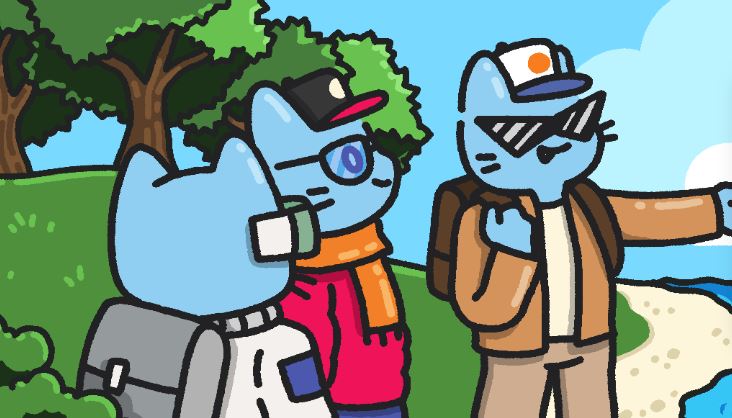Do the Cool Cats still have Blue Chip status? The collection fell on hard times lately, but so has any other NFT project out there. We’re in a bear market, after all. A Hollywood agency manages the Cool Cats project, they had the coolest exhibit in NFT NYC, and collaborated with TIME magazine in a weird NFT drop. Still, the collection’s floor price is down to levels not seen since the project’s conception.
The Cool Cats started spreading good vibes in July 2021. It’s a PFP collection consisting of 9.999 unique cats assembled from various traits that could form 300K possibilities in total. The ecosystem expanded in two major ways a while ago. They launched their secondary collection, the Cool Pets, and their own token, $MILK. The new coin is the blood that powers the gamified experience that the collection’s creators have been releasing.
— Mike Tyson (@MikeTyson) July 9, 2021
Speaking about those, the core team are: the smart contract programmer Tom Williamson, web developer Rob Mehew, creative director Evan Luza, and illustrator Colin Egan AKA The Cartoonist. The unofficial fifth member of the band is Mike Tyson. A few days after launch, the eternal heavyweight champion changed his Twitter profile picture to a Cool Cats and that propelled the collection when it needed it the most.
The Relationship Between Cool Cats And CAA
The Cool Cats went Hollywood on March 2021. In a move unprecedented at the time, the creators signed with leading talent agency CAA. In a press release from the time, the partners explained the deal in detail:
“Leading entertainment and sports agency Creative Artists Agency (CAA) has signed Cool Cats, producers of the widely known Cool Cats and Cool Pets NFT collections. In collaboration with the gamified NFT company, the agency will identify and create opportunities for Cool Cats characters across an array of areas, including licensing and merchandising, animated content, brand partnerships, live events, publishing, and more.”
So, there’s serious money and interests behind the cats. Why are they fading away into the background, then? Is it just an effect of the bear market?
ETH price chart for 09/24/2022 on OkCoin | Source: ETH/USD on TradingView.com
Cool Cats ’ got utility
First of all, Cool Cats holders get their NFT’s property rights. That means, they can produce commercial projects with their NFT’s images. Cool Cat owners also get access to the project’s Discord server, and priority for all of the exclusive Cool Cats events and mints. Holders can stack their NFTs and get yield in $MILK.
Another benefit is access to Cooltopia, a project they define as “a gamified ecosystem built on interactivity and utility, community rewards and growth, collaboration with brands, and much more.” Another self-definition has Cooltopia as a “place where having a Cool Cats NFT grants you evolving access to games, tokens, community events, collaborations, and more.”
Plus, there’s the Cool Pets side project. A reward to NFT holders and a way for newcomers to enter the ecosystem at a lower price point. The Cool Pets collection has 19,999 units. Every holder got a pet for free and the general public bought the other half. The Cool Pets first come as an egg image that hatches and reveals the final NFT. The pets are divided into four elements: Fire, Water, Air, and Grass.
The $MILK token
The $MILK is an ERC20 token on the Ethereum and Polygon blockchains. It’s the oil that greases Cooltopia’s gamified economy. According to the documentation:
- “$MILK is the key to all sorts of functionality and fun in the Cool Cats ecosystem, from buying Battle or Housing chests to going on quests.”
- “$MILK is also how you’ll enhance and evolve your Cool Pets.”
- This one describes the NFTs staking-like mechanism: “Your Cool Cat is earning $MILK just by being cool (the $MILK claiming clock begins as soon as the contract is deployed), and that $MILK will accumulate over time.”
Controversy And Suspicion
There might be something strange going on with this project. In April, the newly-appointed CEO stepped down after just three months. There was never a credible explanation given. The collection just tweeted, “Chris Hassett has stepped down as CEO. We thank him and wish him the best moving forward.” Is there problem brewing in the Cool Cats headquarters?
And then there’s the price. At its height, in October 2021, the Cool Cats floor price was around 26 ETH. Almost a year later, the floor Cool Cats are trading for 2.9 ETH. That’s not all, the Cool Pets’ floor price is currently at 0.18 ETH. Are those Blue Chip numbers? Even though we’re basically in the middle of a crypto winter, the collection seems to be falling off a cliff…
Will the Cool Cats land on their feet?
Featured Image: screen shot from the collection’s site | Charts by TradingView
